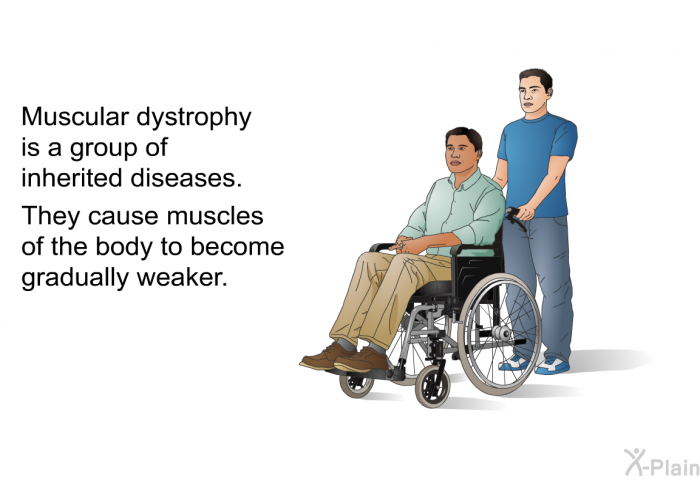What is muscular dystrophy? Muscular dystrophy refers to a group of more than 30 genetic (inherited) conditions that affect the functioning of your muscles. In general, the symptoms of muscular dystrophy worsen over time. These conditions are a type of myopathy, a disorder of your skeletal muscles. Muscular dystrophy is a group of inherited diseases that causes weakness. They also cause wasting away of muscle tissue. There are multiple types of muscular dystrophy. Each type leads to loss of strength, increasing disability, and possible deformity. The most common muscular dystrophy is Duchenne muscular dystrophy. There are many types of muscular dystrophy: Duchenne (DMD), Becker (BMD), Myotonic (DM), Limb-Girdle (LGMD), Facioscapulohumeral (FSHD), Congenital (CMD), Distal (DD), Oculopharyngeal (OPMD) and Emery-Dreifuss (EDMD).
There are many types of muscular dystrophy: Duchenne (DMD), Becker (BMD), Myotonic (DM), Limb-Girdle (LGMD), Facioscapulohumeral (FSHD), Congenital (CMD), Distal (DD), Oculopharyngeal (OPMD) and Emery-Dreifuss (EDMD). Muscular dystrophy refers to a group of hereditary disorders that cause progressive, generalised muscle weakness and atrophy. Muscular dystrophy is a non-communicable disorder and has many variations - each variation has a specific inheritance pattern, time of. Muscular dystrophies are progressive, generalised diseases of muscle, most often caused by defective or specifically absent glycoproteins (e.g., dystrophin) in the muscle membrane. All muscular dystrophies are characterised by ongoing degeneration and regeneration of muscle fibres. What is muscular dystrophy? Muscular dystrophy (MD) refers to a group of genetic diseases that cause progressive weakness and degeneration of skeletal muscles. These disorders (of which there are more than 30) vary in age of onset, severity, and the pattern of the affected muscles. The muscular dystrophies are a group of rare conditions that gradually cause muscles to weaken and waste. Sometimes you may see or hear them being talked about as neuromuscular conditions, or as a muscle wasting and weakening condition.
Muscular dystrophies are progressive, generalised diseases of muscle, most often caused by defective or specifically absent glycoproteins (e.g., dystrophin) in the muscle membrane. All muscular dystrophies are characterised by ongoing degeneration and regeneration of muscle fibres. What is muscular dystrophy? Muscular dystrophy (MD) refers to a group of genetic diseases that cause progressive weakness and degeneration of skeletal muscles. These disorders (of which there are more than 30) vary in age of onset, severity, and the pattern of the affected muscles. The muscular dystrophies are a group of rare conditions that gradually cause muscles to weaken and waste. Sometimes you may see or hear them being talked about as neuromuscular conditions, or as a muscle wasting and weakening condition. The muscular dystrophies (MD) are a group of inherited genetic conditions that gradually cause the muscles to weaken, leading to an increasing level of disability.
